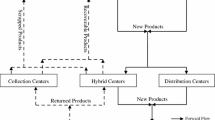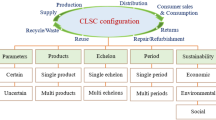Abstract
Over the last decade, there has been increased attention to closed-loop logistics networks. Environmental legislation requires companies to be more responsible by collecting used products from customers. Companies can also benefit from savings that are related to recovering and recycling used products. Unlike previous studies, which only consider single products or a single period of time in multi-objective problems, this paper considers a multi-product multi-period closed-loop logistics network with different types of facilities. A multi-objective mixed-integer nonlinear programming formulation is developed to minimize the total cost, the delivery time of new products, and the collection time of used products. Thus, this model better approximates real-life applications of closed-loop logistics problems. Interactive fuzzy goal programming (IFGP) is applied to solve the model for handling multiple objective problems with conflicting objectives and to address the imprecise nature of decision-makers’ aspiration levels for goals. The results from computational experiments performed here show that by changing the upper or lower bound of each objective function, one can obtain a better final solution of the problem and also can provide more options for decision makers to choose from based on their situation. Finally, the utilization rate of facilities is shown to be an important indicator when designing a logistics network.




Similar content being viewed by others
References
Aznar, J., Guijarro, F., & Moreno-Jimenez, J. M. (2011). Mixed valuation methods: a combined AHP-GP procedure for individual and group multicriteria agricultural valuation. Annals of Operations Research, 190, 221–238.
Deb, K. (2008). Multi-objective optimization using evolutionary algorithms. New York: Wiley.
El-Sayed, M., Afia, N., & El-Kharbotly, A. (2010). A stochastic model for forward-reverse logistics network design under risk. Computers & Industrial Engineering, 58(3), 423–431.
Ergu, D., & Kou, G. (2011). Questionnaire design improvement and missing item scores estimation for rapid and efficient decision making. Annals of Operations Research. doi:10.1007/s10479-011-0922-3.
Fleischmann, M., Krikke, H. R., Dekker, R., & Flapper, S. D. P. (2000). A characterisation of logistics networks for product recovery. Omega, 28(6), 653–666.
Fleischmanin, M., Beullens, P., Bloemhof-Ruwaard, J. M., & Van Wassenhove, L. N. (2001). The impact of product recovery on logistics network design. Production and Operations Management, 10(2), 156–173.
Hu, C. F., Teng, C. J., & Li, S. Y. (2007). A fuzzy goal programming approach to multi-objective optimization problem with priorities. European Journal of Operational Research, 176, 1319–1333.
Jayaraman, V., Guide V. D. R. Jr., & Srivastava, R. (1999). A closed-loop logistics model for remanufacturing. Journal of the Operational Research Society, 50(5), 497–508.
Krikke, H., Bloemhof-Ruwaard, J., & Van Wassenhove, L. N. (2003). Concurrent product and closed-loop supply chain design with an application to refrigerators. International Journal of Production Research, 41(16), 3689–3719.
Lee, D. H., Bian, W., & Dong, M. (2007). Multiobjective model and solution method for integrated forward and reverse logistics network design for third-party logistics providers. Transportation Research Record, 2032(06), 43–52.
Listes, O. (2007). A generic stochastic model for supply-and-return network design. Computers & Operations Research, 34(2), 417–442.
Marin, A., & Pelegrin, B. (1998). The return plant location problem: modeling and resolution. European Journal of Operational Research, 104(2), 375–392.
Mutha, A., & Pokharel, S. (2009). Strategic network design for reverse logistics and remanufacturing using new and old product modules. Computers & Industrial Engineering, 56(1), 334–346.
Narasimhan, R. (1980). Goal programming in a fuzzy environment. Decision Sciences, 11, 325–336.
Pishvaee, M. S., & Torabi, S. A. (2010). A possibilistic programming approach for closed-loop supply chain network design under uncertainty. Fuzzy Sets and Systems, 161(20), 2668–2683.
Pishvaee, M. S., Farahani, R. Z., & Dullaert, W. (2010). A memetic algorithm for bi-objective integrated forward/reverse logistics network design. Computers & Operations Research, 37(6), 1100–1112.
Pishvaee, M. S., Rabbani, M., & Torabi, S. A. (2011). A robust optimization approach to closed-loop supply chain network design under uncertainty. Applied Mathematical Modelling, 35(2), 637–649.
Salema, M. I. G., Povoa, A. P. B., & Novais, A. Q. (2009). A strategic and tactical model for closed-loop supply chains. OR Spektrum, 31(3), 573–599.
Wang, H., & Hsu, H. (2010). A closed-loop logistic model with a spanning-tree based genetic algorithm. Computers & Operations Research, 37(2), 376–389.
Werners, B. (1987a). An interactive fuzzy programming system. Fuzzy Sets and Systems, 23, 131–147.
Werners, B. (1987b). Interactive multiple objective programming subject to flexible constraints. European Journal of Operational Research, 31, 342–349.
Werners, B. (1988). Aggregation models in mathematical programming. In G. Mitra (Ed.), Mathematical models for decision support (pp. 295–305). New York: Springer.
Zimmermann, H. (1978). Fuzzy programming and linear programming with several objective functions. Fuzzy Sets and Systems, 1, 45–55.
Author information
Authors and Affiliations
Rights and permissions
About this article
Cite this article
Mehrbod, M., Tu, N., Miao, L. et al. Interactive fuzzy goal programming for a multi-objective closed-loop logistics network. Ann Oper Res 201, 367–381 (2012). https://doi.org/10.1007/s10479-012-1192-4
Published:
Issue Date:
DOI: https://doi.org/10.1007/s10479-012-1192-4




